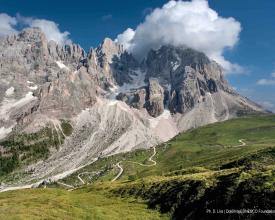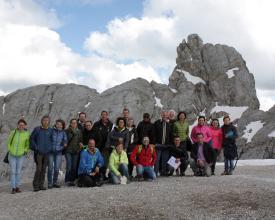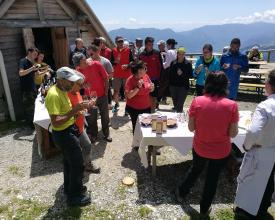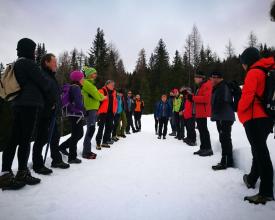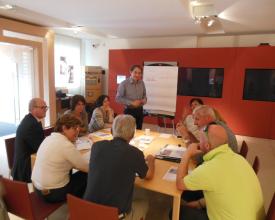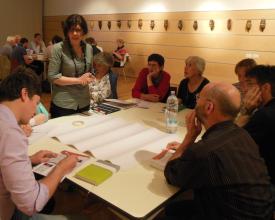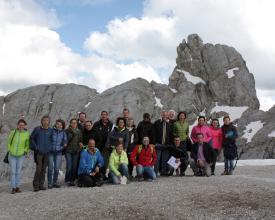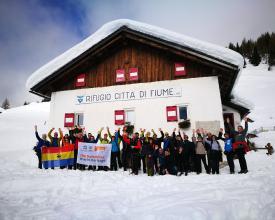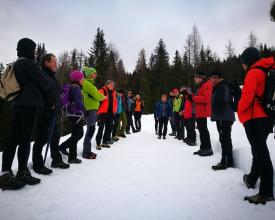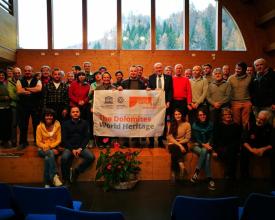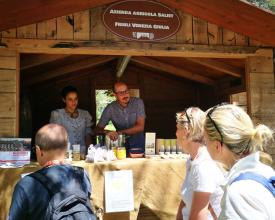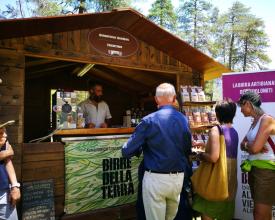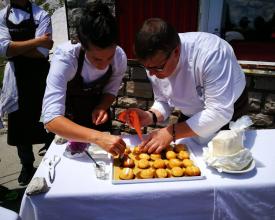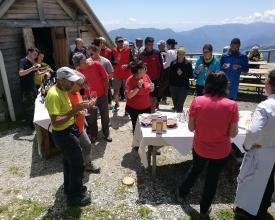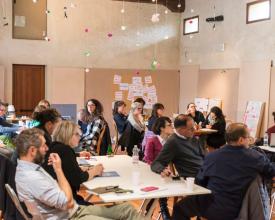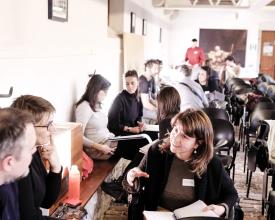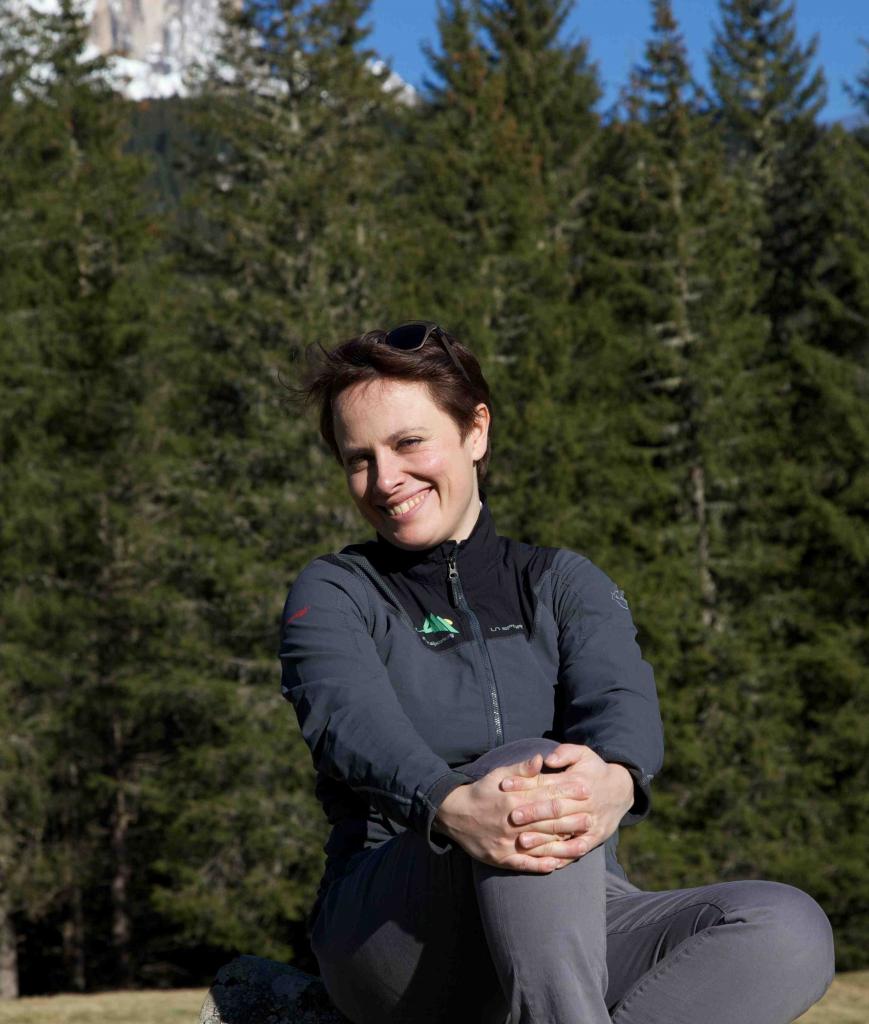
Salvaguardar el paisaje montañoso vivo de los Dolomitas
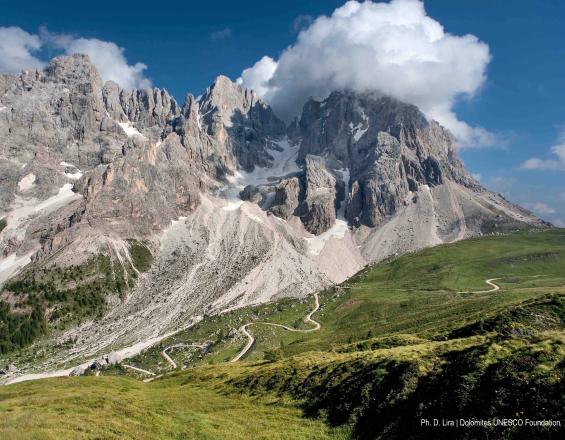
Los Dolomitas se inscribieron en la Lista del Patrimonio Mundial en 2009 como grupo de nueve sistemas montañosos. Inscritas con arreglo a los criterios (vii) y (viii) por sus valores geológicos, las Dolomitas son una mezcla de múltiples y dinámicos paisajes alpinos naturales y conformados por el hombre. Los Dolomitas no son solo un sitio natural excepcional, sino también un lugar de gran diversidad cultural e historia formado por comunidades con múltiples antecedentes culturales, comunidades de minorías, un amplio espectro de tradiciones y sitios culturales, así como uno de los templos del alpinismo, que fue inscrito en la Lista del Patrimonio Cultural Inmaterial de la UNESCO en 2019.
La solución se centra en el papel desempeñado por múltiples redes formales e informales de comunidades e instituciones en la sensibilización sobre los valores del Sitio y la promoción de la enorme diversidad natural y cultural de los Dolomitas, al tiempo que se persigue la conservación activa del paisaje, así como la sostenibilidad medioambiental, económica y social.
Contexto
Défis à relever
La solución se centra en el trabajo realizado para fomentar la inclusión de las comunidades locales y las partes interesadas locales en la gestión del rico patrimonio natural y cultural de los Dolomitas.
La solución aborda los siguientes retos
- Retos medioambientales: utilización de los recursos naturales, reparto de beneficios con los agentes locales, consideración conjunta, holística, de las necesidades de desarrollo económico y conservación para encontrar un camino viable y sostenible.
- Retos sociales: cambios en las comunidades y los agentes locales, sistema de gobernanza complejo que requiere el compromiso de los agentes políticos e institucionales de cinco provincias y dos regiones, cambios políticos e institucionales en los puestos de liderazgo, concienciación de la población sobre el Valor Universal Excepcional y otros valores.
- Retos: desarrollo económico local, producción de alimentos en las regiones montañosas, desconexión entre productor y consumidor de alimentos, desarrollo del turismo.
Ubicación
Procesar
Resumen del proceso
Los cinco pilares interactúan entre sí en la construcción de un enfoque participado de la gestión y conservación de los Dolomitas como Patrimonio de la Humanidad, área protegida y conjunto de paisajes culturales.
El proceso participativo #Dolomites2040 contribuyó a la creación de la Estrategia de Gestión del Sitio, en la que el compromiso activo de las comunidades locales y la gestión en red son esenciales. #Dolomites2040 sentó así las bases para el establecimiento de plataformas clave de conexión como los "Refugios de montaña Dolomitas Patrimonio Mundial de la UNESCO" (BB2) y los "Produttori di Qualità" (BB2) y la red de museos (BB5). Estas plataformas capacitan a actores locales clave para convertirse en embajadores de la promoción del Valor Universal Excepcional junto con otros valores naturales y culturales de los Dolomitas. Estos actores locales desempeñan un papel clave en la sensibilización del público en general sobre la importancia de la conservación de los Dolomitas a través de sus experiencias, sus vidas y sus productos tangibles e intangibles (BB6).
Bloques de construcción
#Dolomites2040: un enfoque participativo para contribuir a la Estrategia Global de Gestión del sitio
La estrategia #Dolomites2040 es un proceso participativo que puso en marcha la Fundación UNESCO Dolomitas en 2015. En el proceso participaron autoridades del parque, administraciones locales, consorcios de la industria turística, asociaciones ecologistas, hoteleros, agricultores y asociaciones profesionales con el objetivo de elaborar un conjunto de recomendaciones para la estrategia de gestión del bien Patrimonio Mundial de los Dolomitas sobre cuatro macrotemas: turismo, desarrollo socioeconómico, conservación activa y creación de relaciones.
El proceso participativo se llevó a cabo a través de una serie de 11 reuniones con un pequeño grupo de personas utilizando el método World Café; durante las reuniones los participantes debatieron cuestiones clave sobre cómo les gustaría ver los Dolomitas en 2040 buscando formas de garantizar la conservación así como de apoyar el sustento de las personas que viven dentro y cerca de la propiedad.
Esta información, propuestas y preocupaciones han sido clave para la creación en 2015 de la Estrategia de Gestión Global y la Estrategia de Turismo, y el establecimiento de orientaciones de gestión y conservación a corto, medio y largo plazo que abordan tanto la protección del Valor Universal Excepcional como cuestiones de importancia local.
Factores facilitadores
Un sólido marco institucional global, que a través de la Fundación UNESCO Dolomitas (FD4U) está facultada para actuar a escala local y regional en el compromiso de las comunidades locales, los gobiernos y otros agentes locales. La Fundación consta de una serie de organizaciones institucionales que promueven el diálogo entre las autoridades territoriales (Consejo de Administración), los objetivos científicos (Comité Científico), las cuestiones socioeconómicas y medioambientales (Consejo de Partidarios) y los intereses de las autoridades locales (municipios y comunidades).
Lección aprendida
Durante estos cafés y reuniones, los participantes de las comunidades locales, instituciones y otros agentes locales tuvieron la oportunidad directa de compartir propuestas e ideas, así como dudas y preocupaciones que tenían en relación con la conservación a largo plazo del lugar, el desarrollo económico de la zona y el sustento de las comunidades.
El proceso puso de relieve la importancia de fomentar la participación y cooperación locales para mejorar la gestión de los Dolomitas. El compromiso de todas las partes interesadas es una inversión constante que debe hacerse para permitir la gestión y conservación eficaces de la zona, junto con la salvaguarda de los modos de vida locales y tradicionales y la interacción con los recursos naturales.
El proceso ha permitido a las instituciones de gestión identificar mejor las estrategias para hacer frente a las críticas de los agentes locales y crear medios para el desarrollo social y económico de las comunidades locales en armonía con la naturaleza.
Capacitar a los propietarios y gestores de refugios de montaña
En 2016, la Fundación UNESCO Dolomitas, en cooperación con la asociación de montañeros y alpinistas y los propietarios y gestores de 66 refugios de montaña de la zona núcleo del Bien, han puesto en marcha el proyecto "Refugios de montaña Dolomitas Patrimonio Mundial de la UNESCO". El proyecto tiene como objetivo reforzar las capacidades de los gestores de refugios de montaña como partes interesadas clave para la gestión eficaz de los Dolomitas y actores clave en la comunicación y promoción de los valores de los Dolomitas.
Esta asociación se ha reforzado aún más mediante la adopción de la Convención de los Refugios de Montaña de los Dolomitas Patrimonio Mundial de la UNESCO en 2017, que se centra en impulsar el papel simbólico de los refugios, promoverlos como proveedores de información y elevar el nivel de sus alojamientos y su rendimiento medioambiental.
El proyecto se centró no solo en la instalación de paneles y puntos de información, sino también en actividades de formación y capacitación dedicadas a los propietarios y gestores de refugios de montaña. Estas actividades se centraron en la información clave del Patrimonio Mundial de la UNESCO y en la comprensión del Valor Universal Excepcional de los Dolomitas y su estructura de gestión.
Factores facilitadores
Un marco de cooperación entre la Fundación UNESCO Dolomitas, las asociaciones de montañeros y alpinistas y los 66 gestores de refugios de montaña.
La experiencia del proceso participativo #Dolomites2040, que a través de la implicación de todas las partes interesadas relevantes había identificado el papel esencial que desempeñan los propietarios de refugios en la salvaguarda del lugar y del territorio en general (experimentar la cultura local, oportunidades para que la gente se conozca y permanezca en los Dolomitas).
Además, el proyecto contó con la colaboración de la Escuela de Gestión de Trentino.
Lección aprendida
El proceso creó una oportunidad para la participación de las principales partes interesadas. Los propietarios y gestores de los refugios desempeñan un papel clave en el contacto con el público en general y los visitantes. Su concienciación es clave para configurar una experiencia de visita más sostenible y respetuosa con el lugar.
La inscripción de los Dolomitas en la Lista del Patrimonio Mundial ha permitido que la gente sea más consciente del valor natural y cultural de los Dolomitas y de su rico paisaje cultural; el proyecto se convirtió en una oportunidad para reconocer y comunicar los valores culturales del lugar.
El proyecto ofreció a los propietarios y gestores de refugios de montaña la oportunidad de participar más activamente en la comunicación y promoción de los valores de los Dolomitas, así como en la mejora de la calidad de vida de sus habitantes.
Si se utiliza con cuidado, el estatus de Patrimonio Mundial de la UNESCO puede servir de certificación para apoyar el desarrollo sostenible de las actividades turísticas. Esto requiere una mayor inclusión de las principales partes interesadas.
Producción de calidad: conectar la producción alimentaria con los refugios de montaña
El bloque de construcción se centra en la red de productores agrícolas y ganaderos que se ha creado en el marco del proyecto "Produttori di Qualità"(en español "productores decalidad"). La red está formada actualmente por 72 particulares/pequeñas empresas locales dedicadas a la producción de alimentos y bebidas certificados por su calidad. La red incluye productores centrados en la creación de productos de calidad más que de cantidad.
El proyecto se centró en aumentar la conciencia de vivir y operar en un lugar declarado Patrimonio de la Humanidad y en crear redes significativas de buenas prácticas y cooperación entre productores, valorando la especificidad de cada producto.
Esto también se ha convertido en una plataforma para la creación de una conexión directa entre la producción de calidad y los refugios de montaña, y por lo tanto la mejora de la experiencia de los lugareños, visitantes, turistas, así como la promoción de los productos locales y la creación de un medio para un desarrollo económico sostenible. En estos casos, los agricultores y ganaderos no sólo son considerados usuarios del entorno natural, sino actores activos en la conservación del paisaje de los Dolomitas.
Factores facilitadores
La existencia de diferentes sistemas de certificación y/o reconocimiento de las producciones y productos de calidad es clave para el establecimiento de una red virtuosa y sostenible.
Comprender los valores añadidos por los agricultores, los ganaderos y el paisaje agrícola/ganadero al valor de los Dolomitas.
La Estrategia de Gestión Global del Sitio incluye un objetivo estratégico específico sobre la promoción de economías sostenibles y de productos locales, estableciendo un marco institucional para que el proyecto se desarrolle como parte de la estrategia de gestión global de los Dolomitas.
Lección aprendida
La importancia de fomentar y apoyar el desarrollo económico sostenible a través de la producción de alimentos y bebidas de calidad es un elemento clave para la habitabilidad a largo plazo de los Dolomitas y un elemento clave para evitar una mayor despoblación de las regiones de montaña.
Implicar a los productores en una red activa ha permitido involucrarlos en la concienciación sobre el valor de los Dolomitas, así como en la toma de conciencia de estos valores a la hora de considerar las actividades que llevan a cabo.
Las sinergias entre productores y "usuarios" (gestores de refugios de montaña) eran necesarias para garantizar la viabilidad económica de la producción, pero también como elementos clave para la creación de experiencias turísticas sostenibles.
Sensibilización a través de la experiencia de la población y las comunidades locales
La concienciación sobre los valores de los Dolomitas como bien del Patrimonio Mundial es necesaria para la conservación a largo plazo del lugar, pero también es una disposición de la Convención del Patrimonio Mundial.
Para seguir avanzando en los esfuerzos de concienciación entre los ciudadanos, las comunidades y los agentes locales que viven en los Dolomitas y en sus proximidades, la Fundación UNESCO Dolomitas ha creado un segmento televisivo semanal llamado "Noi, Dolomiti UNESCO" (en español "Nosotros somos los Dolomitas de la UNESCO") en el que se presentan las experiencias y las vidas de las personas que viven, operan y/o trabajan dentro del territorio de los Dolomitas. La serie se emite a través de los principales canales de televisión de las cinco provincias y las dos regiones en las que se encuentran los Dolomitas, y a través de YouTube.
El objetivo de esta actividad es sensibilizar a un nivel más amplio de las comunidades regionales y territoriales, centrándose en los valores naturales y culturales del lugar, pero explorando también la vida social y económica de las comunidades y personas locales.
Factores facilitadores
Compromiso activo de las partes interesadas locales, los productores y las comunidades que viven en la zona de los Dolomitas a través de redes formales e informales establecidas, desde la experiencia del proceso Dolomitas 2040 hasta la red de refugios de montaña y productores.
Acuerdos con redes y canales de medios de comunicación locales.
Lección aprendida
El estatus de Patrimonio Mundial de la UNESCO es complejo de entender para las personas que no están alfabetizadas en el lenguaje y los procedimientos de la Convención del Patrimonio Mundial. "Noi Dolomiti UNESCO" permite a la población local hablar en nombre del sitio con sus propias palabras y, por lo tanto, esta serie humaniza la cuestión de la protección de los valores naturales y culturales del sitio. Esta es una manera de ofrecer una ventana a la comprensión de la red de cooperación que hay detrás del complejo sistema de gestión establecido, pero también de sensibilizar sobre la labor realizada por las comunidades locales en la conservación de los múltiples valores de los paisajes de los Dolomitas.
Recursos
Red de museos e itinerarios culturales
La red es una oportunidad para explorar la riqueza cultural de los Dolomitas en relación con su Valor Universal Excepcional, a través de una serie de museos multilingües (incluidas las minorías) situados en comunidades de montaña e itinerarios culturales realizados para explorar los Dolomitas y sus gentes e historia. Dado que los museos desempeñan un papel clave en la vida de las comunidades locales y apoyan el registro de la historia y las experiencias locales a lo largo del tiempo, estos lugares también son fundamentales para comunicar los valores de los Dolomitas a través de varias perspectivas naturales y culturales.
Los museos y los itinerarios culturales desempeñan un papel clave en la sensibilización sobre la vida de las comunidades locales y la experiencia vivida por estos territorios desde la prehistoria, pasando por las dos guerras mundiales hasta nuestros días, a través de acontecimientos que han modelado profundamente las comunidades culturales y sociales de estas zonas. La red de museos es una plataforma clave para la interacción directa con las comunidades locales y para que éstas compartan sus conocimientos sobre los Dolomitas y los acontecimientos históricos que han modelado sus paisajes.
Por último, pero no por ello menos importante, ofrecen a las personas con discapacidades físicas la oportunidad de explorar los Dolomitas de forma accesible.
Factores facilitadores
La existencia de varios museos en todo el territorio de los Dolomitas interesados en colaborar para dar a conocer los aspectos naturales, culturales e históricos de estas zonas y sus comunidades.
Estos museos territoriales desempeñan un papel en la vida de las comunidades locales y tienen un propósito en la educación de los visitantes que exploran los Dolomitas tanto a gran altitud como a baja altitud.
La sólida y completa red de actores institucionales e informales que se gestiona a través de la Fundación UNESCO Dolomitas
Lección aprendida
La sensibilización sobre los Dolomitas y sus valores naturales requiere la comprensión de su entorno natural, social y cultural. Los Dolomitas se extienden por una zona de gran riqueza cultural que es a la vez fuente de valores culturales únicos y espejo de un complejo mosaico de identidades locales de comunidades cultural y socialmente diversas.
Los museos, con su fuerte declinación local y su profunda impregnación en los tejidos sociales y culturales de las diferentes zonas de los Dolomitas, son una gran plataforma para participar activa y significativamente en la vida de las comunidades y permitirles compartir sus conocimientos y recuerdos, que constituyen una valiosa información para la gestión eficaz de los Dolomitas y sus valores multicapa.
Recursos
Impactos
La solución se centra en los enfoques que se han puesto en marcha para lograr un compromiso mayor y más activo de las comunidades en la salvaguardia del patrimonio natural y cultural de los Dolomitas. Estos enfoques han contribuido ampliamente a fomentar la capacitación de los agentes locales como embajadores y guardianes del lugar, así como a reconocer el papel clave que desempeñan en la sensibilización del público en general.
Las repercusiones medioambientales, sociales y económicas de este proceso están estrechamente interconectadas y en su mayoría se verán a largo plazo. Sin embargo, la concienciación es crucial para obtener resultados duraderos, porque sólo una comunidad concienciada puede compartir objetivos y percibirlos como positivos y deseados, en lugar de impuestos.
La solución pasa por colaborar con las principales partes interesadas en el desarrollo de un proceso económico sostenible que permita la subsistencia de las comunidades locales a través de un sistema virtuoso de producción y hospitalidad de calidad que tenga en cuenta el medio ambiente y a las personas que viven en esta zona montañosa.
La solución consiste en poner en marcha múltiples plataformas para la participación directa de la población con el fin de identificar de forma cooperativa problemas, puntos de incertidumbre, así como soluciones y procesos innovadores que puedan beneficiar al lugar y a sus habitantes.
Beneficiarios
Comunidades locales que viven dentro y cerca de la zona de los Dolomitas, gestores de refugios de montaña y productores locales de productos alimentarios (agricultores, ganaderos, buscadores de alimentos). Otros beneficiarios son las zonas protegidas y las tradiciones y prácticas culturales .

